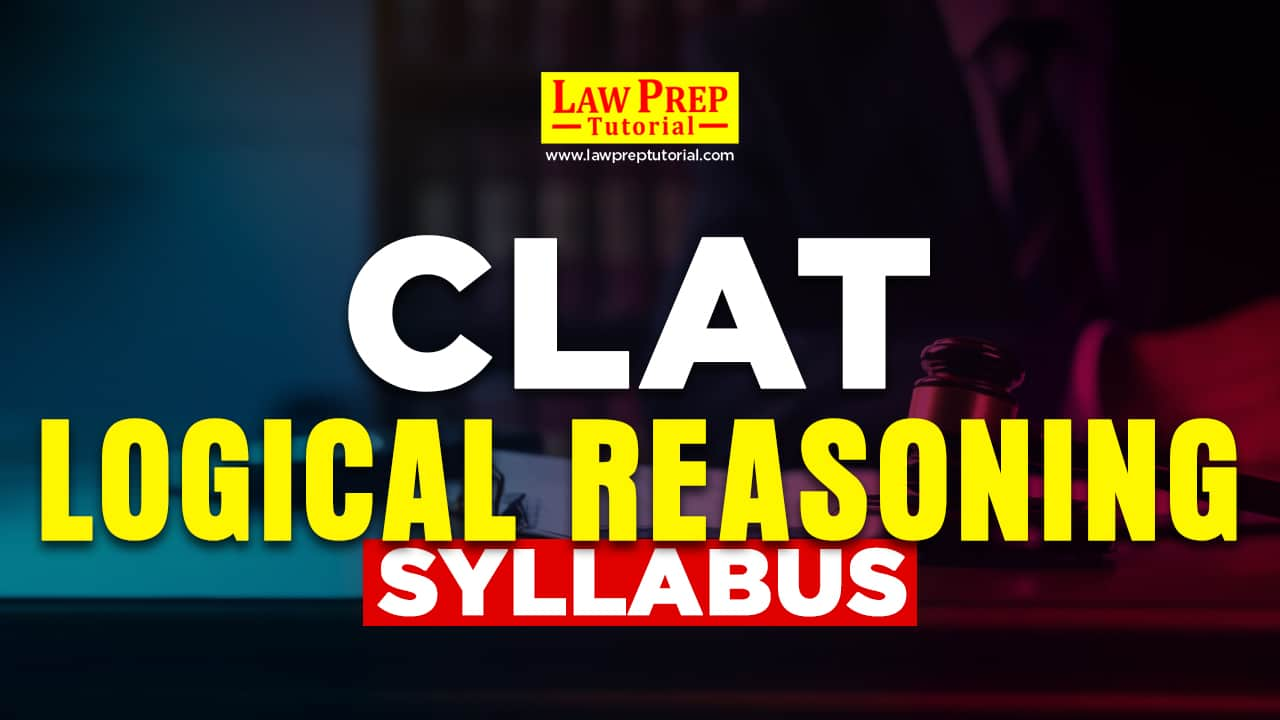Understanding the logical reasoning syllabus for CLAT 2025 is crucial for any aspiring law student. This segment of the exam tests your ability to think critically and solve problems effectively, skills that are indispensable in the legal field.
Here, we will discuss the latest CLAT logical reasoning syllabus, exploring the types of questions you can expect and the key areas you need to focus on to score well. Whether you are just beginning your CLAT preparation or looking to refine your logical reasoning skills, this guide will provide you with all the necessary insights to prepare confidently for CLAT 2025.
Upcoming CLAT Exams:
CLAT Logical Reasoning: Overview
Logical Reasoning is an important section of the Common Law Admission Test (CLAT), designed to evaluate a candidate’s ability to logically analyze and solve problems using legal and factual scenarios. This section tests not only the reasoning skills but also the critical thinking and problem-solving abilities essential for a successful career in law.
This section aims to assess:
- Analytical Ability: The capacity to understand and structure arguments logically.
- Critical Thinking: Evaluating information systematically to make reasoned conclusions.
- Problem Solving: Applying logic to solve complex problems with multiple variables.
| Aspects | Details |
| Type Of Questions | Objective-type (MCQs) |
| No. of Questions | 22-26 |
| Total Marks | 22-26 |
| Weightage | Around 20% |
| Correct Answer | +1 Marks |
| Incorrect Answer | -0.25 Marks |
Logical Reasoning Syllabus for CLAT 2025: Overview
Now, let’s explore the logical reasoning syllabus for CLAT 2025. The syllabus covers various topics, each designed to assess different aspects of your logical reasoning abilities. Below is an overview:
- Recognize an argument comprising premises and conclusions.
- Identify the arguments presented in the passage.
- Critically analyze patterns of reasoning.
- Assess how conclusions rely on specific premises or evidence.
- Evaluate how alterations in premises or supporting facts affect conclusions.
- Infer implications from the passage and apply them to new scenarios.
- Identify relationships, analogies, contradictions, and equivalence within arguments.
- Evaluate the effectiveness of arguments.
These questions assess your ability to evaluate the logical validity of assumptions, conclusions, and inferences based on given statements.
Also read: How to prepare for CLAT?
CLAT Logical Reasoning Syllabus 2025
Let’s delve deeper into each CLAT logical reasoning syllabus to understand its scope and topics:
1. Logical Deductions and Syllogisms
Logical deductions and syllogisms focus on your ability to draw logical conclusions from given statements or premises. These questions typically involve assessing the validity of arguments and drawing inferences based on logical rules.
Key concepts include:
- Rules of Inference
- Logical Sequences
- Categorical Syllogisms
- Statements and Assumptions
- Validity and Invalidity of Arguments
Practice is key to mastering logical deductions and syllogisms. Why is it so? As it enhances your ability to apply logical rules effectively.
2. Logical Connectives and Statement Evaluation
Logical connectives and statement evaluation questions test your understanding of logical relationships between statements. You’ll encounter questions involving logical operators such as ‘and’, ‘or’, ‘not’, and ‘if-then’.
Key concepts include:
- Logical Equivalence
- Statement Contradictions
Understanding the meanings of different logical connectives and practicing with various statement evaluation questions is essential for success in this section.
3. Analytical Reasoning
Analytical reasoning, also known as logical reasoning or puzzles. It comprises a significant portion of the CLAT logical reasoning section. Additionally, it involves solving complex problems by analyzing relationships and constraints provided in the question.
Understanding the nuances of each topic and practising a variety of problems is crucial for mastering analytical reasoning.
4. Critical Reasoning
Critical reasoning questions test your ability to identify assumptions, draw logical conclusions, and evaluate arguments. These questions often involve analyzing passages and determining the strengths or weaknesses of the arguments presented.
Key skills include:
- Recognizing Logical Fallacies
- Evaluating Argument Structure
- Identifying Premises and Conclusions
Practice critical reasoning questions extensively to enhance your ability to analyze arguments effectively.
Also read: CLAT Exam Syllabus
Best Books for CLAT Logical Reasoning Syllabus
Here are some of the best books for CLAT 2025 Logical Reasoning:
1. Verbal and Non-Verbal Reasoning by R.S. Aggarwal
This book is a recommended resource for preparing for logical reasoning in CLAT 2025.
2. Logical and Analytical Reasoning by A.K. Gupta
This book is suggested for candidates looking to strengthen their logical and analytical reasoning abilities.
These books provide comprehensive coverage of the topics and question types for the logical reasoning section of CLAT 2025.
Important CLAT Questions for Practice:
| CLAT Legal Reasoning Questions | CLAT Logical Reasoning Questions |
| CLAT English Questions | CLAT GK Questions |
Things to Know About CLAT Logical Reasoning Syllabus
The following is a more detailed explanation of the CLAT syllabus for logical reasoning 2025:
1. Passage Format
The CLAT logical reasoning Section presents candidates with short passages of around 450 words. These passages serve as the basis for the questions that follow.
2. Question Types
Following each passage, candidates encounter questions that are of multiple-choice objective type. This format requires candidates to select the most appropriate answer from a set of options provided.
3. Time Limit
It is essential for candidates to manage their time effectively while tackling the Logical Reasoning Section. Each passage, along with its corresponding questions, should ideally be completed within 10 to 20 minutes. Failure to adhere to this time frame may result in insufficient time for addressing other sections of the CLAT exam.
Also read: CLAT Exam Pattern
Types of Questions in CLAT Logical Reasoning
Below is a passage from CLAT previous year paper along with questions to help you understand what kind of questions are asked in this section:
Passage
“The depreciation of an economy’s currency is not a matter of concern in itself. The decline in value against major currencies has to be viewed within a set of macroeconomic factors. The recent depreciation of the Indian rupee is a case in point. The rupee has been depreciating for a long time. What are of concern now are the rate at which the depreciation is occurring and the underlying factors causing the change. The Russia-Ukraine war has disrupted supply chains causing commodity prices to rise, leading to a worldwide hardening of inflationary trends. This, in turn, has caused major central banks to raise interest rates, forcing investors back to the safe haven of the US dollar. For India, these headwinds from the global economy have caused several problems. The rise in international prices, especially of crude oil, has led to a higher import bill and, hence, a greater demand for dollars. Higher interest rates in developed country markets have caused a significant outflow of portfolio investments from India, aggravating the already climbing demand for dollars from a rising import bill. By May 2022, foreign institutional investors had pulled out Rs. 1.50 lakh crore from Indian markets.
In the face of these pressures, the rupee, left to itself, would decline in value as the rupee-price of a dollar would increase substantially. One way the Reserve Bank of India could stem the tide would be to sell off dollars in the market to ease the supply situation. However, this would mean that while the value of the rupee could be contained, the nation’s foreign exchange kitty would start to erode further. The RBI has been doing exactly that. The challenge before the RBI is this: how much to let the rupee depreciate and how much to intervene to prop it up? Too much depreciation would raise domestic inflation rates as the rupee-price of imports, especially oil, would raise costs of production. It could trigger a rise in policy-controlled interest rates while closely monitoring inflationary expectations. The biggest challenge is to navigate unpredictable international economic shocks in the near future. The Indian economy’s health is not exactly at its best. Exports may not be able to take advantage of a falling rupee since international demand is expected to stagnate. India’s growth and employment situations are yet to stabilise to what they were about a decade ago. The RBI has difficult choices: controlling inflation versus stimulating growth and stabilising the rupee without severely diminishing the economy’s foreign exchange kitty.”
Questions
1. Which of the following is the author most likely to agree with?
A. It is a major cause for concern if an economy’s currency is depreciating.
B. Currency depreciation is not a reason for worry in itself, but if macroeconomic factors are not good, there may be a cause for concern.
C. The fact that the Indian rupee is witnessing a decline in value against major currencies is very worrisome.
D. A central bank must always do everything in its power to stem the slightest depreciation of an economy’s currency.
Answer: B
2. Based on the author’s arguments, which of the following, if true, would reduce the decline in value of the rupee?
A. Appointing a new Governor for the RBI who has a better sense of how to control inflationary trends.
B. A steep increase in commodity prices and the continued disruption of supply chains.
C. A reduction in worldwide inflationary trends and the reduction of interest rates in developed country markets.
D. The RBI buying as many dollars as possible from the market.
Answer: C
3. Which of the following, if true, would most weaken the author’s arguments?
A. The Indian economy has been affected by global inflationary trends and the increase of interest rates in developed country markets.
B. Since developed country markets have increased their interest rates, global investors have pulled their investments out of other economies, and routed them to such developed country markets.
C. As the demand for US dollars increases, it is likely the rupee-price of a dollar would increase substantially.
D. The Indian economy and currency are highly protected and have been insulated from the effects of global inflationary trends and the increase of interest rates in developed country markets.
Answer: D
4. Which of the following, if true, would most strengthen the author’s arguments for why Indian exports may not be able to take advantage of a falling rupee?
A. Economies across the world are witnessing a slowdown, and in such economies, demand for imports decreases substantially.
B. Economies across the world are booming, and there is an increasing demand for Indian exports.
C. A reduction in the volume of exports would be more than offset by the increased value of dollars that Indian exporters would earn.
D. Countries across the world have managed to find ways to insulate themselves from the effects of the Russia-Ukraine war and will need a lot of Indian imports to sustain their new growth models.
Answer: A
5. Based on the author’s arguments, which of the following must necessarily be true?
A. The continuing depreciation of the Indian rupee at its current rate, coupled with worldwide inflationary trends, would result in immense political instability in India, and consequently, in all of South Asia.
B. If nothing else is done, the rise of interest rates in developed country markets, coupled with hardening of inflationary trends across the world, will result in a fall in the value of the rupee against the dollar.
C. If inflationary trends continue to harden across the world, and if interest rates in developed country markets continue to rise, portfolio investors will increase their investments in India, and this will have a positive impact on India’s foreign exchange reserves.
D. If nothing else is done, the rise of interest rates in developed country markets, coupled with hardening of inflationary trends across the world, will result in a rise in the value of the rupee against the dollar.
Answer: B
5. Which of the following is the author most likely to agree with?
A. The RBI must not focus solely on preventing the depreciation of the rupee, as that may result in negative impacts on other aspects of the economy.
B. The RBI must focus solely on preventing the depreciation of the rupee at all costs, since it is by far the most important indicator of the health of the Indian economy.
C. Periodic inflationary trends are normal in any economy, and the RBI need not worry about the inflationary effects in the Indian economy caused by the depreciation of the rupee.
D. The RBI need not do anything to reduce the rate of depreciation of the rupee, since the depreciation of an economy’s currency is not a matter of concern in itself.
Answer: A
Browse more CLAT Logical Reasoning Questions and CLAT Logical Reasoning Passages by clicking on the linked texts.
Important Resources After CLAT Exam:
Tips to Prepare for CLAT Logical Reasoning Syllabus
Preparing for the logical reasoning topics of CLAT requires a strategic approach. This will effectively tackle the diverse range of topics and question types. Here are detailed preparation strategies, including some new insights:
1. Understand the Question Types
Begin by familiarizing yourself with the various question types commonly encountered in the Logical Reasoning section. For example, analytical reasoning, logical deductions, syllogisms, logical connectives, and critical reasoning. Understanding the nuances of each question type will enable you to approach them strategically.
2. Develop Analytical Skills
Logical reasoning questions often require candidates to analyze complex scenarios and draw logical inferences. Sharpen your analytical skills by practising tasks that involve critical thinking, problem-solving, and pattern recognition. Engage in activities such as solving puzzles, playing strategy games, and participating in debates to hone your analytical abilities.
3. Practice Regularly
Consistent practice is key to mastering logical reasoning topics for CLAT. Dedicate a portion of your study time each day to practicing questions from different topics. Make use of CLAT preparation books, online resources, and mock tests. Doing this will expose you to a wide range of question types and difficulty levels.
4. Focus on Time Management
Keep in mind the given time constraints of the CLAT exam. Why? It is essential to develop effective time management strategies for the logical reasoning section. Practice answering questions within the specified time limit to enhance both your speed and accuracy. Furthermore, learn to prioritize questions based on their difficulty level and allocate time accordingly.
5. Identify Patterns and Techniques
As you practice, pay close attention to recurring patterns and techniques used in logical reasoning questions. Recognize common patterns and understand the underlying principles behind various question types. This will help you approach them more confidently during the exam.
6. Review Mistakes
Mistakes are valuable learning opportunities. Practice sets or take mock tests from time to time. After completing them, take the time to review your answers and identify any errors or areas of weakness. Analyze the reasoning behind each question and understand why certain choices are correct or incorrect. This process will help you learn from your mistakes and improve your performance.
7. Stay Updated
Keep yourself updated with any changes or updates to the CLAT syllabus and exam pattern. Stay informed about recent developments in logical reasoning topics and current affairs, as these may influence the content of the exam questions.
8. Seek Guidance if Needed
While preparing, obviously, you will encounter difficulties with specific topics or question types. If this happens, don’t hesitate to seek guidance from mentors, teachers, or online forums. Join study groups or online communities where you can discuss challenging concepts, share strategies, and learn from others’ experiences.
Adopt these detailed preparation strategies along with consistent practice and dedication. With this, you can enhance your proficiency in logical reasoning and maximize your performance in the CLAT exam.
FAQs About CLAT Logical Reasoning Syllabus
The Logical Reasoning section of the CLAT comprises about 28-32 questions, accounting for approximately 20% of the total marks in the exam.
Preparation should include practicing with sample questions and previous years’ papers to familiarize yourself with the question types. Studying from reliable logical reasoning books and engaging in activities that enhance critical thinking, like puzzles and problem-solving games, can also be beneficial.
A good strategy is to read each question carefully and identify key information and question demands before attempting to solve. Manage your time efficiently, ensuring you have enough time to tackle all questions. It’s also beneficial to answer easier questions first to secure quick marks and then move on to more complex problems.
Time management is crucial, as the Logical Reasoning section can be time-consuming due to the complexity of some questions. Practicing under timed conditions using the CLAT test series can help improve your speed and accuracy, which is essential for completing the section within the allotted time.
Wrapping Up:
Mastering the Logical Reasoning section is crucial for excelling in the CLAT 2025 exam. Effective preparation, guided practice, and a clear understanding of question types are essential.
For aspirants aiming to top the exam, joining offline or online coaching for CLAT by Law Prep Tutorial can make a significant difference. Renowned as India’s #1 CLAT institute, Law Prep Tutorial has a proven track record, producing toppers annually, including five AIR 1 rankings in the last seven years and the AIR 1 in CLAT 2024.
Free CLAT Study Material for You:
| CLAT Previous Year Papers PDF | CLAT Sample Papers |
| CLAT Syllabus PDF | Free CLAT Coaching |
| CLAT Current Affairs | CLAT Topper Interviews |
| CLAT Videos | CLAT Mock Tests |
Must Know for Every CLAT Aspirant:



